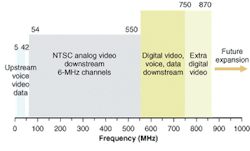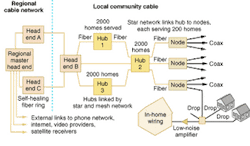It's easy to underestimate cable television. Market analysts generally don’t put cable TV in the top rank of fiber markets. Yet if you live in an average suburban community, it's likely that the fiber closest to your home belongs to a cable company. Cable companies have long used fiber to distribute signals from local operations centers, called “head ends,” to neighborhood nodes. As the industry has consolidated, the few remaining major players have linked local head ends to regional operations centers. Now new changes are reshaping cable networks. The spread of cable modems for high-speed Internet links and the marketing of premium video services are driving current upgrades. Another round of changes should follow as cable companies try to introduce high-definition digital television. And video services are part of the first small wave of commercial fiber-to-the-home services.
CATV architecture
What we now call “cable television” began as “community antenna television” or CATV and originally relied entirely on coaxial cable (coax) to distribute analog video signals. Channels were frequency division-multiplexed onto the cable in the same frequency bands used for broadcast TV, although as cable companies added more channels they often shifted the signals to different frequencies. A branch-and-tree coax network distributed signals from a central “head end” to customers whose homes all received the same signals, although premium channels were scrambled.
The high attenuation of coax at high frequencies necessitates amplifiers every few hundred meters and the problems with those amplifiers earned cable networks a reputation for poor reliability. Failure of one repeater knocked out cable service to everyone further down the branch. Reducing the need for long cascades of amplifiers had to wait for development of highly linear analog optical transmitters. Once they became available, cable companies began adopting the hybrid fiber-coax (HFC) approach, which remains standard today (see Fig. 1). In the simple star network of Fig. 1, fiber cables radiate from the head end to several hubs in a city. Separate fiber cables spread from each hub to several distribution nodes, where the optical signals are converted into electronic format and delivered over coax to individual subscribers.
Modern cable networks transmit signals both upstream and downstream. A single coaxial cable can carry signals in both directions at different frequencies. Normally fibers transmit signals in only one direction, so bidirectional transmission requires either a pair of fibers, or a pair of wavelengths going in opposite directions in the same fiber, usually one at 1310 nm and the other at 1550 nm.
The combination of fiber and coax can carry analog signals at frequencies up to about 1 GHz, although some bands in that range carry digital signals encoded in analog form. That spectrum is divided into four broad ranges (see Fig. 2). The low-frequency range between 5 and 42 MHz is reserved for upstream transmission of digital cable-modem traffic, cable telephony, and control signals. Traditional analog television channels are transmitted downstream at frequencies between 54 and 550 MHz, with each channel assigned a 6 MHz band. Digital video channels usually are transmitted between 550 and 750 MHz, although some newer systems can go as high as 870 MHz. Higher frequencies are held in reserve for future services; their usability depends on the coax part of the network.Digital television
Digital television is a hot topic that will have major impact on the cable industry, but it's also a confusing one. The television industry uses the "digital" label in two different ways—one for high-quality transmission of conventional video, the other for a new television standard designed to offer higher resolution.
Conventional television uses the analog NTSC standard, which nominally transmits 30 interlaced frames per second at 525 lines per frame. Analog broadcasting and VCRs degrade the signal to varying degrees. Digitizing the signal and compressing the data stream can deliver a better-quality version of the signal. “Digital cable” delivers signals in this format, as do digital satellite services and DVDs. Compression is so efficient that several digitized video signals can be squeezed into the bandwidth normally used for one analog channel. Cable systems transmit these signals at the high end of the standard cable band. Generally cable companies include some premium channels in their digital video package, and charge a premium price. Note that the signals come through the same coaxial cable on a different frequency band, although they may be transmitted separately over fibers in some parts of the cable network.
The U.S. digital television broadcast standard transmits a signal in a different format that can support 18 levels of screen resolution. Six of these are high-definition formats with 1080 or 720 lines per screen, and 12 are standard definition formats with 480 lines designed for smaller screens. Digital compression converts a raw signal rate of 1.5 Gbit/s to a 19.3-Mbit/s signal that can be transmitted in a 6-MHz analog video channel—a main criteria that determined the American digital television standard. These signals require special digital tuners, which won't be required on large-screen (36-in.) sets until 2005 and on all televisions until 2007.
Congress and the FCC have pushed some broadcasters to begin transmitting in the new digital format by giving them new channels for the purpose. Otherwise, however, adoption of the new digital standard has been stalled by a Byzantine morass of political complications and the staggering prices of televisions with screens large enough to benefit from high-definition images. Cable companies and television manufacturers recently agreed on a digital version of "cable ready" sets that can directly accept new digital signals from cable networks, but no hardware is likely to be ready until 2004. Meanwhile, Congress and the FCC are considering proposals to shut down analog broadcasts at the end of 2006. Whenever the transition to digital happens, it will have much more impact on transmission electronics and set-top boxes than on fiber deployment.
Fiber to the home
Large cable companies have devoted even less attention to fiber-to-the home systems than their counterparts in the telephone industry. Yet several smaller companies have actually begun to deploy fiber to the home. Last year the Fiber to the Home Council reported that in August a total of 50 communities had started installing fiber links to homes. Those new systems fall almost entirely into two distinct markets: large-scale housing developments, and rural areas and small cities.
“Green-field” developments are tempting targets because they are built from scratch, with completely new utilities. This greatly reduces the installation costs that make overbuilding existing communities with new fiber networks extremely expensive. Developers are betting that the extra costs of fiber can be offset by higher prices and faster sales for houses also loaded with other amenities. So far, they seem to be winning their bet. New developments account for just under half the fiber systems listed by the Fiber to the Home Council. Typical of new housing construction, most are targeted at upscale markets. The lowest prices for attached houses among four developments in suburban Virginia are around $250,000.
Overbuilds of existing communities are confined to rural areas, small towns, and cities that are often poorly served by large cable companies. Most are funded by publicly owned utilities, municipal agencies, or cooperatively owned small telephone companies, which have access to long-term, low-cost loans. They get public support by delivering new services at cost. Some hope that high-speed Internet access will encourage industry to move to the area. Others are simply looking to the future, phasing in fiber to replace outdated plant. Most hope to sell a “triple play” of services—voice, video, and high-speed Internet access.
The differences in the two leading fiber-to-the-home architectures—passive optical networks (PONs) and Gigabit Ethernet—are significant for video transmission, although less evident than for data transmission. Both can provide standard cable television service by wavelength-division multiplexing an analog video signal at a wavelength separate from the data wavelength. Typically video transmission is at 1550 nm, where transmitter costs and powers are both high, while upstream transmission is with less-costly 1310-nm sources. The high raw data rates of Gigabit Ethernet make it attractive for video on demand, but PONs can also transmit Ethernet.
Outlook
Cable television may not be making exciting progress in fiber technology, yet as survivors of the bubble know, exciting is not necessarily good. Cable companies have moved slowly, adapting their networks to meet changing needs. In the short term, their biggest technical challenge is the planned transition to the new digital television standard, now far behind schedule and in danger of becoming a major fiasco. In the longer term, the biggest challenge will be dealing with fiber to the home, which could be anything from a money pit to a quantum leap in telecommunications.
Further Reading
Walter Ciciora, James Farmer, and David Large, Modern Cable Television Technology: Video, Voice, and Data Communications (Morgan Kaufmann, San Francisco, 1999).
About the Author
Jeff Hecht
Contributing Editor
Jeff Hecht is a regular contributing editor to Laser Focus World and has been covering the laser industry for 35 years. A prolific book author, Jeff's published works include “Understanding Fiber Optics,” “Understanding Lasers,” “The Laser Guidebook,” and “Beam Weapons: The Next Arms Race.” He also has written books on the histories of lasers and fiber optics, including “City of Light: The Story of Fiber Optics,” and “Beam: The Race to Make the Laser.” Find out more at jeffhecht.com.



